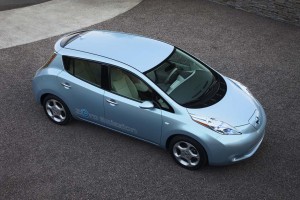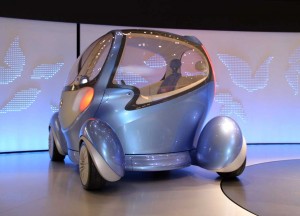
Can Nissan make a profit on the Leaf, even while charging no more than a comparable, gasoline-powered small car?
Nissan is kicking off a 22-city tour designed to promote the first of four battery-electric vehicles, or BEVs, that it plans to bring out over the next several years.
The debut event coincided with the announcement of a new joint venture with Reliant Energy, one of the largest electric utilities in the U.S. The automaker has been racing to ink a series of joint ventures with utilities, battery producers and even governments, such as Portugal and Israel, in its bid to make electric propulsion not just the darling of environmentalists but a competitive alternative to the conventional internal combustion engine.
While the battery car program is the pet project of Nissan’s hard-charging CEO Carlos Ghosn, the man who has to pull it all together is Hideaki Watanabe, the general manager of the automaker’s advanced propulsion program. The ebullient executive was on hand during the Zero-Emissions Tour kickoff, in Los Angeles, discussing the program in only faintly accented English, which he honed during a three-year stint in the United States.
Watanabe discussed the challenges of battery technology, as well as some unexpected advantages that, he feels, could attract customers not simply driven by “eco-guilt.” He spoke with TheDetroitBureau.com Publisher Paul A. Eisenstein.
TheDetroitBureau: Everyone at Nissan seems to be, if you’ll pardon the pun, charged up about battery vehicles. Why, considering so many competitors are still reluctant to comit to the technology?

The Nissan Leaf features a fairly conventional design, but Watanabe suggests a more radical shape, like the Nissan Pivo2 concept vehicle, could be used in the future.
Watanabe: Technology-wise, this (the Nissan Leaf) is an exciting car. When you talk about electric vehicles, people think we’re going to build a dull car, but it’s not. On top of its zero emissions, it’s exciting. The initial acceleration is much better than many V-6 cars, so it has an advantage in acceleration – and we want to sell it for the same price as a “normal” car.
(Click Here for a review of the new Nissan Leaf.)
TDB: The design is different than many other electric vehicles, in that you’ve mounted the batteries below the floor. Why?
Watanabe: The layout of this vehicle moves the center of gravity to the middle of the car and lower than that of a comparable vehicle with a gasoline engine. That delivers perfect weight balance to improve handling, as well as performance.
TDB: If you’re pushing Leaf’s performance, why didn’t you first launch a sports car, like Tesla, with its Roadster, which it claims is as fast as a Porsche 911?
Watanabe: It’s about volume. Our strategy is to go for enough volume to make this a sustainable business. We didn’t think you could do that selling a niche vehicle. Our focus is, first, on a C-segment vehicle that we can sell in Japan, Europe and the US.
TDB: Competitors, notably including Toyota, are focusing on hybrids or more advanced plug-ins. Why didn’t Nissan?
Watanabe: Hybrid is good technology, but it still depends on the internal combustion engine. We didn’t want to mix the two.
TDB: Some makers, again including Toyota, are talking about offering hybrid powertrain options, along with conventional I-4s, V-6s and V-8s, available on almost all products. Might Nissan someday offer a battery-only powertrain on vehicles like the Altima or Maxima?
Watanabe: It could be a possibility. The question is whether it would be more efficient to produce separate battery vehicles because the basic layout of a battery vehicle is very different from one with an internal combustion engine.
TDB: So why not make Leaf or another battery vehicle look even more radical?
Watanabe: Why didn’t we make it look like a spaceship? We wanted it to be distinctive, but our designers also wanted it to be acceptable to more conservative buyers.
TDB: But, eventually, you do have the option to make a car that’s truly different from what’s on the road today.
Watanabe: It can be completely different. We could put the motors right in the wheels, like the Pivo (a concept vehicle shown, in different versions, at recent Tokyo Motor Shows). Wheel motors could give you all-wheel-drive, and you don’t need all the conventional mechanical linkages (ie to the steering wheel and pedals). You don’t need all the space up front where an internal combustion engine normally is, so you can free up even more space.
TDB: One of your senior battery engineers told TheDetroitBureau.com, recently, that the 100 mile range of Leaf could be increased quite significantly, once the lithium-ion battery is improved, perhaps to 200 miles. Do you agree?
Watanabe: We are continuously developing future technology. We’ve worked on lithium-ion for 17 years and battery technology is evolving day-to-day. It’s pretty competent now, but to have a big leap like that in a year or two is not realistic. But 3, 4, maybe 5 years? We’re investing in that.
(Click Here to find more about Nissan’s future battery plans, which could include offering optional, long-range or higher-performance batteries.)
TDB: CEO Carlos Ghosn has said he believes Nissan will make money on the Leaf, even though the plan is to keep its price down around the same as a conventional small car. Is that really possible?
Watanabe: It will be profitable, otherwise, Mr. Ghosn would not let me go through with it. He would stop it. We have various stakeholders and our responsibility is to ensure profitability. We’re not looking at this as a one-shot car. This is just the first (battery) car.
TDB: You’re not worried that many competitors, like General Motors, remain skeptical of the pure battery vehicle?
Watanabe: Being conservative, they feel the technology is not quite ready yet. But we know we need to be competitive (in this market) to win. And it’s good for us to have the advantage by getting a jump and being the leader.
